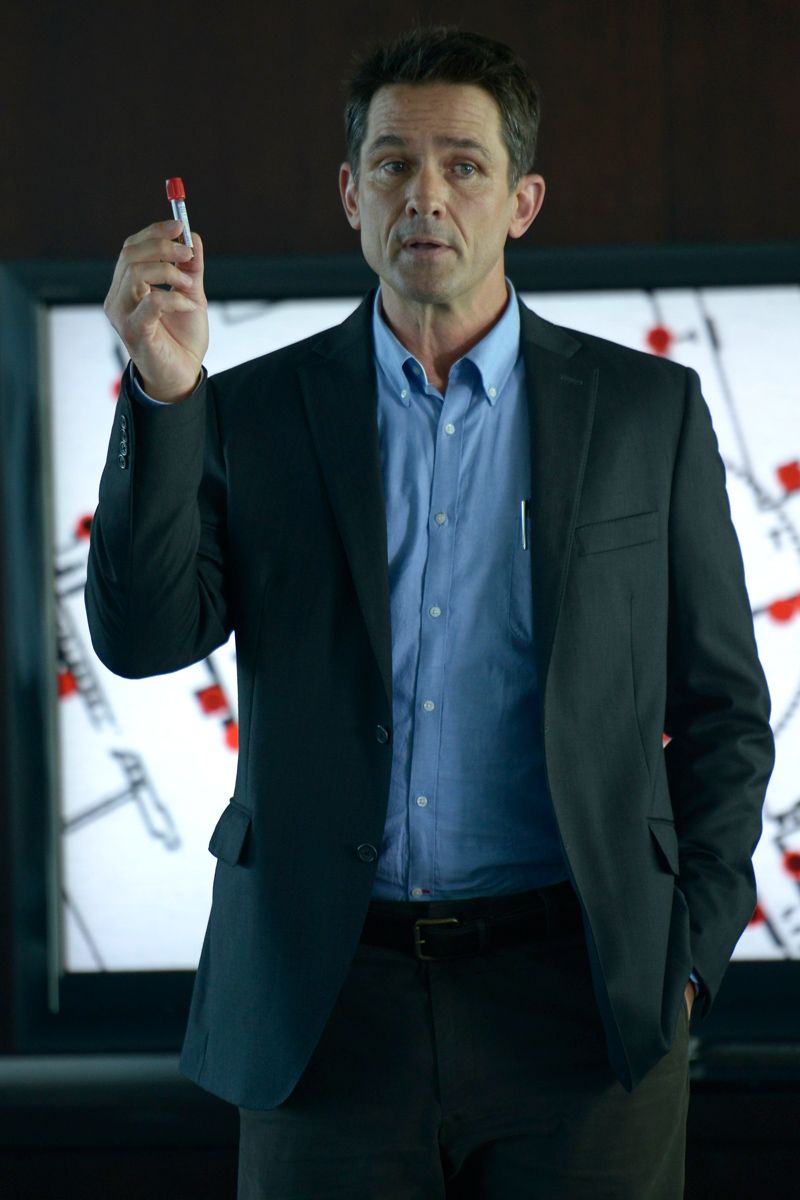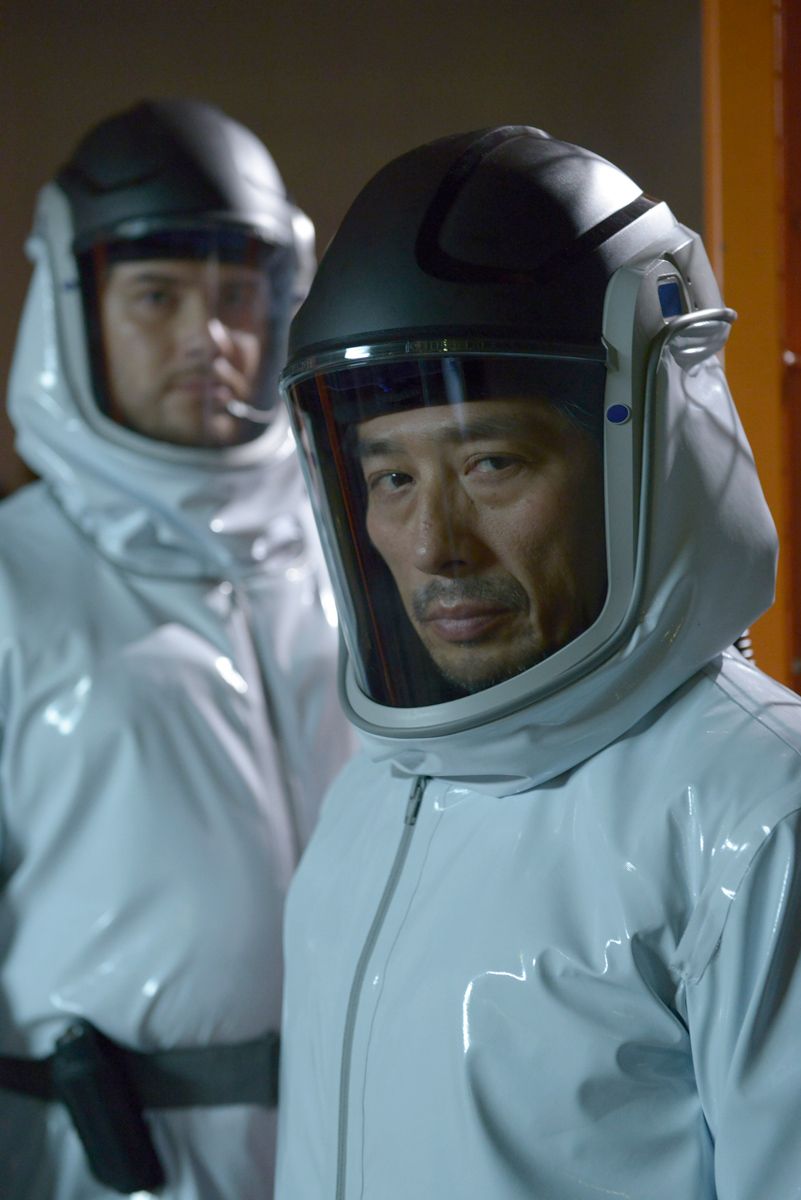Viruses can be silent and deadly, striking with little or no warning. Every gender, age and race is susceptible, and now there’s a deadly new strain about to be unleashed on the chilling Syfy series Helix.
Executive produced by Ronald D. Moore (Battlestar Galactica), the sci-fi thriller premiered Jan. 10 with a team from the Centers for Disease Control and Prevention rushing to a research facility in the Arctic after receiving a distress call. Once there, they discovered a mysterious virus outbreak that transforms the infected into zombies. The CDC experts must uncover the truth behind its origins, and then somehow contain the disease before it’s too late.
Helix showrunner Steven Maeda (Lost, The X-Files), spoke with Spinoff Online about crafting the drama, and the secret to pulling off “scary” on a television budget.
Spinoff Online: Why was a remote facility the perfect setting for Helix?
Steven Maeda: The great thing is if you’re in this place where this disease is spreading, you’re trapped there. You can’t get out. You can’t go outside. It’s almost like you’re in outer space somewhere. You could be on a base on the moon. This doesn’t have to stretch quite that far and yet it still has that sense of claustrophobia and confinement.
What’s the nature of the virus, and how equipped is the CDC to deal with it?
As to what the virus is, I can’t answer that because that’s a big part of what the show is. It’s bad. It’s really scary and it’s really bad. It’s doing terrible things to people. They don’t understand it. The CDC had never seen anything like this before. So, they are as prepared as they can be to go deal with the unknown, which happens sometimes with the CDC. We did a lot of CDC consultations, talking about this sort of thing, but this particular virus is something that we’ve never seen the likes of before.
How does the virus manifest?
You see people walking around in pretty bad shape. It’s debilitating. Some people it seems to kill right away and do some terrible things to the body. Other people manage to survive through it. Our scientists say in the pilot episode, “The virus changes you.” It starts to change you and it starts to transform you into something, but what is the question. That is the heart of the series. What is this virus doing? Why is it doing what it’s doing? Have we been messing with nature? Is it something natural? Is it something that’s been done on purpose? Those are all questions answered in the first season.
Can you introduce us to your lead character, Dr. Alan Farragut?
At the Center, it seems like he’s that square-jawed American hero. We have actor Billy Campbell, who has been tremendous for us and has this rock solid presence and credibility as a scientist and as leader of this team. He’s a guy who is very good at his job and has been doing this for a long time. He’s very passionate about what he’s doing, both from the science angle and the humanity angle of trying to save people from these diseases out there. At the same time, he has a pretty messed-up personal life. He’s let a lot of things go by virtue of the job.
Where does Alan’s infected brother, Peter (Neil Napier), fit into the show?
He’ll figure very prominently. It’s something we talked about a great deal. In the very first version of the story, Peter was dead at the beginning. We decided to leave that character alive. He’s going to be sick, but let’s have him be alive because it gives you all sorts of emotional possibilities for Alan. And then, let’s complicate it even further by creating this romantic triangle that went really bad between Peter, Alan and his wife. Once we came up with that triangle, we were like, “That’s fun. That’s going to give us a lot of opportunity to let these family dynamics play out over the course of the 13 days on this base.”
Why doesn’t the CDC leave or simply call in reinforcements?
The main thing that keeps them inside is the weather. It’s so inhospitable out there. They are really trapped in this place for 13 days. They can’t get out. It’s hard to communicate out. One of the things we set up, and this is based on some research we did, is that at certain times of the year, communication satellites are only up for an hour each day or even less than that. The idea is they have a very small window in which to communicate. It’s not like you can just hop on a cell phone or the internet to get information or send an email. You’re really stuck up there on your own.
How does Jeri Ryan’s character, Constance Sutton, enter the fray then?
I don’t want to give too much away about that. She does have a connection to the base. We were definitely excited to get Jeri, and she was great. She comes in about halfway through the season. She’s someone who is integral to the secrets that are being kept on the base. That is something we’ve been very big on, is everybody has secrets. They have either personal secrets or professional secrets or scientific secrets. Everybody has come in there with baggage or hidden agendas.
Who is Dr. Hiroshi Hatake (Hiroyuki Sanada)?
Hatake is the head of the base. He is the person up there doing the research and makes all the speeches about wanting to be helpful. It quickly becomes apparent that might not quite be the case. We think we know what he’s about. “He’s the guy who has the ulterior motive. He’s up to no good here.” Again, here’s a character who was doing something for reasons we don’t quite understand and seems to be a stereotypical villain, and yet it’s not that at all.
Helix gets intense and creepy fast. How difficult is “scary” to pull off?
It’s not so much as doing “scary,” as opposed to repeating yourself. That was the thing we were always very conscious of because we don’t have a big feature budget. We don’t have huge effects, so a lot of it was what you can’t see.
Another cool thing about the show is the virus itself. Unless you’re looking under a microscope, it’s this invisible enemy that is wandering about. It could be in the air. It could be in the water or anything you touch or eat or breathe. That in itself is scary. What they discover over the course of the show is a lot of the times the enemy you are dealing with is not the virus, but rather the people who are around it.
Why incorporate hallucinations as a storytelling device?
What’s great about hallucinations is they enabled us to get inside a character’s head and tell stories they would not be able to tell. We made a decision very early on not to do flashbacks. Hallucinations allow us to do some of that, but to do it in a way that was really trippy. The hallucinations play perfectly with the tone we are trying to establish for the show as well.
In the end, what can viewers expect on a weekly basis?
What people can expect is to be scared. Maybe not so much the jump out and grab you kind of scares, although we do have some of those. It’s that creeping sense of dread that something is very wrong here. We definitely want to answer all the questions that we ask by the end of the season, but with enough possibility to hopefully lead us to a second season. We can definitely expect lots of good character reveals and surprises and finding out about these hidden agendas.
Helix airs Fridays at 10 p.m. ET/PT on Syfy.



